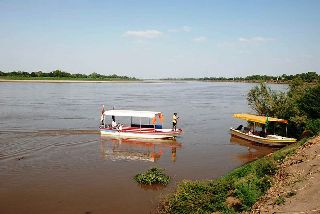Nile project aims to unite riparian communities
By Jamie Freedman and Ali Askouri
January 16, 2013 (ASWAN, Egypt) – Representatives from Nile basin countries including Sudan have travelled to Egypt as part of an international project to improve cooperation on water management issues.

They have been joined by activists from around the world, including the United States, Canada, Germany, the U.K and Japan.
The so-called Nile Gathering in Aswan is the first in a series of events organized by the advocacy group as part of a broader three-year program to address cultural and environmental challenges facing the Nile basin.
The Nile Project is the brainchild of Egyptian ethnomusicologist Mina Girgis and Ethiopian-American singer Meklit Hadero.
The Nile River runs through 11 countries, including Sudan and South Sudan, linking numerous communities and cultures.
However, despite the interdependence of these communities, no attempt has been made to bridge communal and cultural gaps.
“These issues have been ignored in past centuries by politicians and governments,” says one expert, who is interested in how to better strategise the role of communities in the Nile river ecosystem.
The gathering encompasses a four-day strategic planning workshop that builds on the project’s mission to connect the people of the Nile basin through cultural dialogue, followed by a two-week residency program to develop music that can inspire cultural and environmental awareness.
Continuing until January 29, the workshop brings together expertise in the fields of environment, culture, agriculture, finance, education, development, nonviolent communication, cross-cultural dialogue, conflict resolution and intercultural learning
The event is being hosted at the Fekra Cultural Center, a choice which reflects the group’s deep awareness of the historical developments that have taken place in Nubia.
This once powerful kingdom stretches from southern Egypt to northern Sudan and is one of the earliest civilizations to develop in the Nile River valley.
The center is located on the east side of the Nile between the High Dam and the Old Aswan Dam near the Greco-Roman Philae Temple.
The area is the former site of the first cataract of the Nile before it was flooded a century ago.
In the past it also served as the main river harbor between Egypt and Sudan, as well as the African interior before the construction of the Aswan High Dam in 1971.
“We were rich and happy,” laments Fekra Center founder Abdel Khalek El Betiti, pointing towards a deserted railway station.
“Trade between Egypt, Sudan and other parts of Africa passed through the railway station. Now there is nothing.”
The area now stands as a as a stark example of how human attempts to harness nature impact on the lives of local communities and their social and economic ties.
Their daily 15 minute trip from the their hotel in Aswan to the Fekra Center serves as a reminder for event participants of how the first human civilization came to be cut short by modern technologies which have forever altered the landscape and transformed human activity.
Construction of dams along the Nile River by Sudan and the Egyptian government has seen large tracts of Nubian land along with numerous archaeological treasures submerged.
During the 1960s thousands of Nubians were displaced and forcibly relocated to Eastern Sudan, some 700 kilometers from their ancestral homeland.
Sudan is highly dependent on flows from the Nile for domestic and irrigation use and has constructed a number of dams along the river and its tributaries.
Today tensions over water allocations and management issues continue to strain relations between the different Basin countries.
It’s hoped the project will inspire, educate and empower Nile citizens to work together to strengthen the sustainability of the river’s ecosystem.
Girgis says he is excited about exploring new approaches of understanding the Nile as one system where fishing, irrigation, tourism, and transportation are intricately related to climate change, floods, droughts and dams.
“Most of us who live within this system have no idea what these relationships mean”, explains Girgis.
“How do all these worlds affect one another? How do they come together to affect the Nile? And what can we do to help restore the equilibrium of this complex system?” he asked.
(ST)
